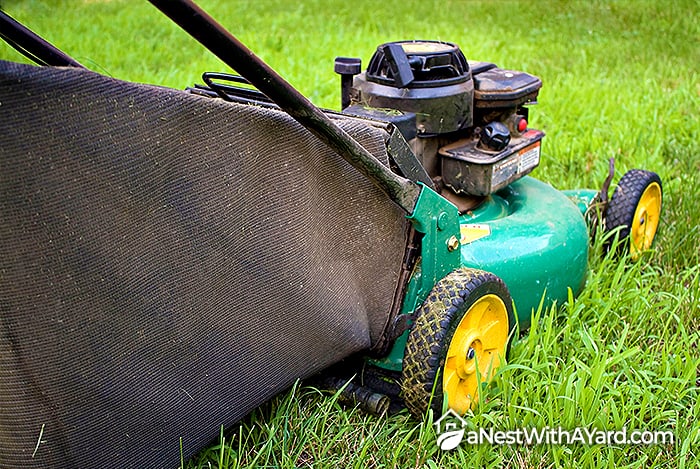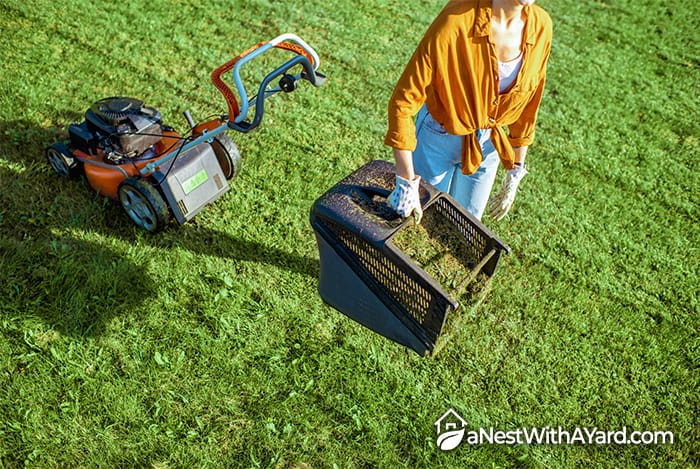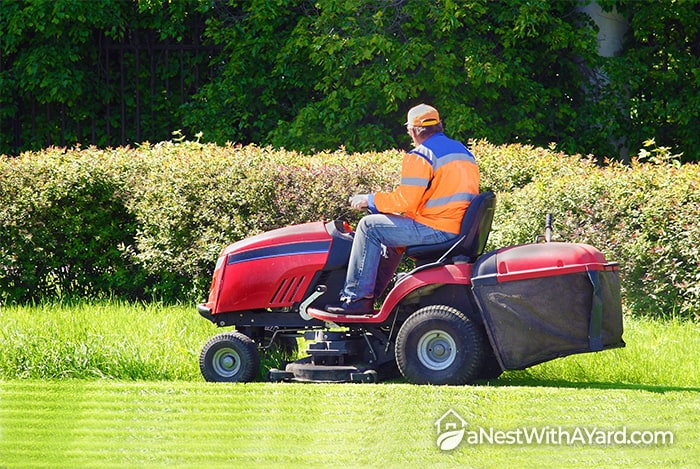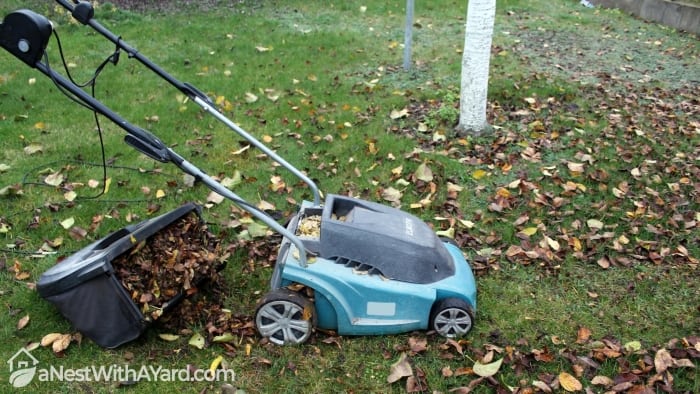Are you tired of raking grass clippings by hand? Can’t bring yourself to sweep up those fall leaves that are long overdue for cleanup?
Sounds too familiar! Landscaping will wear you out without the proper tools and equipment. All you need to do is upgrade your old hand tools that have seen better days with a lawn sweeper or a bagger.
But which one is better – a lawn sweeper vs bagger?
A bagger is amazing at collecting grass clippings, but a lawn sweeper can do much more. A lawn sweeper is capable of sweeping up all kinds of debris and trash from your yard.
It is the overall best option for people who have to maintain large properties. Want to learn more? Keep on reading! I’ve got lots more in store!
Contents
Lawn Sweeper Vs Bagger: Introducing The Opponents
Lawn Sweepers

A lawn sweeper is an ingenious mechanical tool designed to remove grass clippings, fall leaves and twigs, pine needles, and other natural debris from your lawn. You can even use it to sweep litter from your driveway and sidewalk or any other paved surface, for that matter.
A lawn sweeper is equipped with a special mechanism for collecting lawn debris, unlike a bagger. It has a rotating brush hidden underneath its deck that picks up accumulated debris from in between the grass. The brush is made of flexible, soft bristles that won’t damage your lawn when going over it.
The brush inside the sweeper simultaneously deposits the collected junk into a hopper or disposable bag. Using a lawn sweeper is as easy as it gets.
Lawn sweepers come available in many sizes and varieties. Let’s take a closer look at all the options available.
Lawn Sweeper Size
The size of your lawn sweeper should correspond with the size of your property. If you pick a lawn sweeper that is too small for your plot of land, you will have to make more passes to collect all the debris.
On the other hand, a lawn sweeper that is too big will be too cumbersome to navigate around the tight corners of your small property.
You can pick the right size for your lawn sweeper by looking at the width and hopper volume:
- Width: A sweeper’s width will determine how much and how quickly you can collect grass clipping and leaves off the lawn. A 21-inch sweeper is sufficient for a small to medium-sized lawn. For a large property, you will need at least a 48-inch sweeper.
- Hopper volume: A hopper is a reusable bag attached to the back of the trolley. Its size is measured in cubic feet. A 12-cubic foot hopper is sufficient for a small yard. For a large yard, you will need 26 cubic feet or bigger.
Types Of Lawn Sweepers
- Tow Behind Lawn Sweeper: can be attached to your lawn/garden tractor or any large vehicle. As you drive your tractor, you will tow the sweeper behind and engage it in sweeping. Make sure the hitch height on the sweeper matches your tractor before purchase. If you are not sure, pick one with a multi-hitch height.
Don’t have a garden tractor? I have reviewed them just for you. Take a look!
- Push Lawn Sweepers: are manually powered when pushed forwards. As the wheels turn, so does the brush, sweeping up and collecting the organic debris along the way.
- Powered Lawn Sweepers: have a motor that does the job for you. They are either powered by electricity or gasoline. Gas-powered sweepers are used for cleaning public parks, football fields, golf courses, and other large properties. Electric models are best for home use.
Pros:
- Can pick up diverse debris
- Can pick up trash
- Different varieties available
- Various sizes available
- Doesn’t damage grass
- Adjustable sweeping height
- Easy to use and operate
- Requires minimal maintenance
Cons:
- Collected leaves can fly out of the open hopper on a windy day
- Can take up a lot of storage space
- May not perform the best on bumpy terrain
Baggers

A bagger is an accessory for a classic push lawn mower or riding mower. It attaches to the back of the lawnmower where it catches and collects grass clippings as you mow the lawn.
A bagger doesn’t have a special mechanism that picks up the grass clippings. Instead, it relies on the airflow created by lawnmower blades to pick up the debris and bag it through the collection chute.
Vacuum leaf baggers are more advanced. They suction lawn debris through a hose that attaches to the deck of a riding mower. Tow behind vacuum leaf baggers are also equipped with a shredder that makes it possible to fit more leaves in the hopper.
Bagger Size

Baggers are available in many different sizes to match lawns of different proportions. A bagger that comes with your classic lawn mower will have a storage of about 18 gallons, which is roughly 2.4 cubic feet. This size will suffice for a small backyard.
For medium lawns, I recommend buying a bagger that has a bigger capacity, for example, 6.5-bushel, or about 8 cubic feet.
Material collection systems like the TerraKing Leaf Bag can hold a whopping 54 cubic feet, which makes them ideal for large properties. Take a look:
Types Of Baggers
There are lots of different types of baggers available on the market. Breaking them down into just a few types is difficult. Here you can see the pictures of the most popular varieties:


Pros:
- Can be used when cutting grass
- Convenient and easy
- Great for collecting grass clippings and fall leaves
- Lots of varieties available
- Available in different sizes
- Baggers for classic lawn mowers are storage friendly
- Requires minimal maintenance
Cons:
- Their performance relies on a mower
- Can’t pick up trash
- Not the best at collecting wet grass
- Can clog easily
Versus Battle: Features Face To Face
Collecting Ability
It all comes down to efficiency. How many leaves can a device collect in a single sweep?
Lawn sweepers collect leaves fast because of their wide mouths. The wider the lawn sweeper is, the more surface it can cover. You can find lawn sweepers up to 100 inches wide. Such coverage is achieved when multiple smaller lawn sweepers are paired together.
It is impossible to find a bagger with such a large collecting capacity. Baggers are limited by the size of the lawnmower cutting deck. They can collect as wide as a lawnmower or riding mower cuts, which is typically from 42 to 54 inches.
The clear winner of this versus battle is a lawn sweeper. It collects more leaves at once.
Versatility

Both lawn sweepers and baggers are extremely versatile. They can make the tedious work of raking leaves a walk in the park.
A bagger shines when it comes to collecting grass clippings and fall leaves. The lawnmower blade shreds both types of organic matter to make bagging much easier. Lawn sweepers, on the other hand, are pros at picking up different kinds of organic waste.
They can sweep grass clippings, leaves, twigs after pruning, acorns, pine needles, and even trash that the wind has blown onto your driveway.
The clear winner of this battle is the lawn sweeper. It can pick up more diverse lawn debris, as well as trash.
Convenience

A lawn sweeper and a bagger are much more convenient to use than an old-fashioned rake. Still, one is better than the other.
A lawn sweeper is a separate device that you will use after you cut the grass. This means that you will have to go over your lawn at least twice, once when cutting grass and once when collecting it. This may be a little time-consuming.
A bagger collects the grass immediately as you cut it. How convenient is that! Talk about killing two birds with one stone. You will save on time and gas by completing both tasks at once.
The clear winner of this match is the bagger since it is more convenient to use.
FAQs
When Should You Use A Lawn Sweeper?
You should use a lawn sweeper throughout the year to sweep organic debris off your lawn, but it’s best if you use it on a sunny day when the grass is dry. It is more difficult for lawn sweepers to collect wet grass and leaves, but they’re still better at picking up wet grass than baggers.
Is A Lawn Sweeper Worth It?
Owning a lawn sweeper is worth it if you have a yard with lush, fast-growing grass with trees that lose lots of leaves in the fall. Raking such large amounts of lawn debris by hand is exhausting and time-consuming. In this case, a lawn sweeper is worth every penny.
Will A Lawn Sweeper Pick Up Acorns?
A lawn sweeper can pick up acorns as well as pine needles, twigs, fall leaves, and grass clippings. A lawn sweeper can even be used on paved surfaces to pick up trash. The rotating brush can pick up all sorts of lawn debris it comes across.
Do Lawn Mower Baggers Work?
Lawn mowers work great when correctly fitted and attached to the push mower or riding mower. Lawn mower baggers work best when the weather is sunny and the grass is dry. They are bad at bagging wet grass clippings since they get clogged more often in wet conditions.
Landscaping Can Be Fun
One thing is for certain! Maintaining curb appeal with a lawn sweeper or a bagger is easy. Both tools can turn your once exhausting landscaping chores into a fun and exciting hobby.
But first, you have to choose the right tool for your needs. Which one is better? A lawn sweeper vs bagger? Let’s find out:
Buy a lawn sweeper if you:
- Have a lush lawn that requires lots of trimming.
- Have acorns in your yard.
- Would like to pick up trash from your driveway and sidewalk.
- Would like to have a separate device for bagging.
- Intend to bag wet grass every now and then.
- Have a large property that requires upkeep.
- Have plenty of storage space.
Buy a bagger if you:
- Have a push lawn mower, riding mower, or a garden tractor.
- Will mostly bag grass clippings and leaves.
- Would like to cut and collect grass both at once.
- Intend to pick up dry grass.
- Don’t mind making more passes to cover the whole area.
- Are short on storage space.
Last update on 2024-04-25 at 05:59 / Affiliate links / Images from Amazon Product Advertising API

